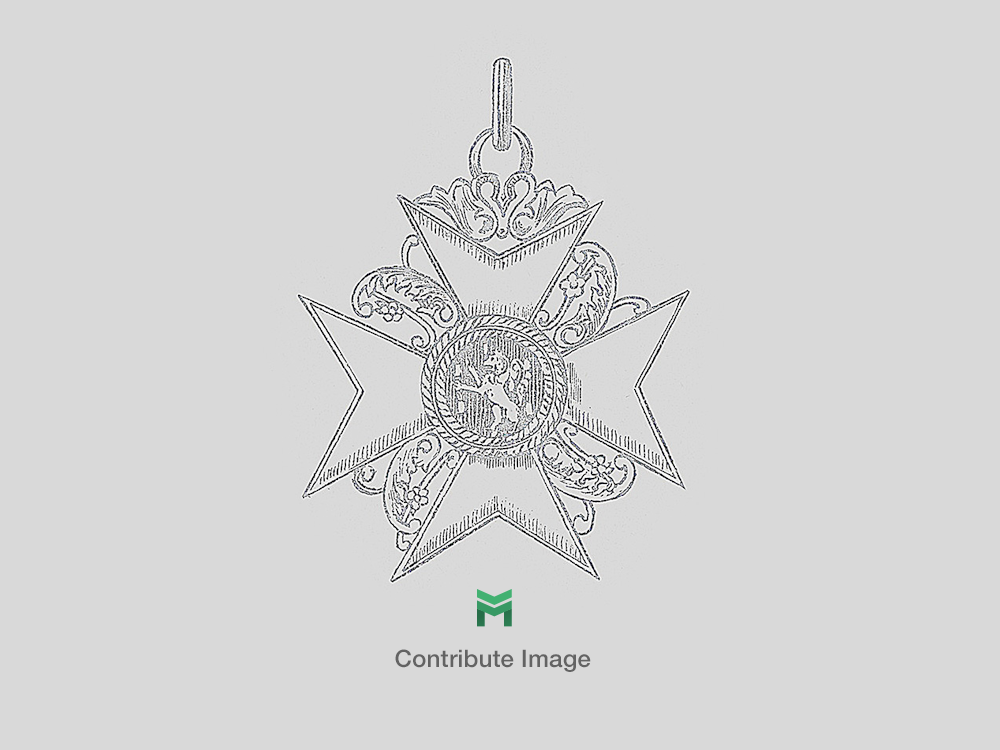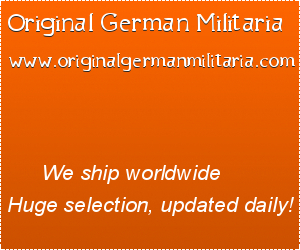Luftwaffe Oberfeuerwehrmann Shoulder Boards
SKU: 22.GOR.03.02.02.03.05.02.002
Estimated market value:

Estimated market value:
Attributes
History
The German Wehrmacht was composed of three main branches, the Heer (Army), the Kriegsmarine (Navy), and the Luftwaffe (Air Force). The Heer and Kriegsmarine uniforms were based upon the designs utilized by their predecessor organizations, the Reichsheer and the Kaiserliche Marine. Conversely, the Luftwaffe uniforms were based upon the uniforms worn in the sports and paramilitary organizations that were the forerunners of the Luftwaffe. The Luftwaffe uniforms were specifically designed to deviate from the designs of the other Wehrmacht service branches. It was also necessary that the uniforms differentiate between military and civilian pilots.
There were two main organizational precursors of the Luftwaffe, the German Air Sports Association (DLV or Deutscher Luftsportverband), and the National Air Raid Protection League (RLB or Reichsluftschutzbund). The DLV included both a civilian group and a secret military sub-group called the DLV-Fliegerschaft (Pilot Base).
The DLV and the RLB were officially founded in 1933, and they were used to secretly train members for future roles in the Luftwaffe. The DLV became obsolete after Hitler’s official introduction of the Luftwaffe in 1935, and it was disbanded in 1937.
Shoulder boards or straps were first and foremost used to identify a soldier’s rank. In certain cases they would also identify the soldier’s branch and unit, and potentially his specific role/career. For these purposes, shoulder boards often feature a branch colour, sometimes complimented by either a letter, a number, or a device, or any combination of these.
Shoulder straps were worn by lower ranks, whereas shoulder boards were worn by higher ranks. The difference lies in the quality of the material, the more elaborate look of the shoulder boards, and the fact that shoulder boards were padded and therefore more stiff, while shoulder straps generally were not. For the sake of simplicity, the terms will be used interchangeably.
Shoulder straps differ in size due to varying production methods and materials, how many numbers and letters they have to hold, and even the wearer’s shoulder size.
The first regulations concerning Luftwaffe shoulder boards were issued on April 22, 1935, within an order that delineated the official forms of Luftwaffe insignia. These shoulder boards identify the rank and branch of service of Luftwaffe personnel. Their design was based heavily on the designs of DLV shoulder boards.
The Shoulder Boards are composed of several main elements, including the cords, the buttonhole, the underlay or piping, the rank pips, and the career insignia. The Luftwaffe shoulder boards were permanently attached to the majority of uniform pieces on which they were worn, including the cloth greatcoat and rock tunic, but when they were worn on the leather overcoat they were removable.
Within the Luftwaffe, there were specific branches/arms of service. Each of these branches was associated with a specific Waffenfarbe (branch colour). These Waffenfarben were included in the design of the rank insignia and other uniform insignia of Luftwaffe personnel. On Officer’s shoulder boards the Waffenfarbe is present in the form of a cloth underlay, while on the shoulder straps of the lower ranks it features in the form of piping.
A simplified overview of the Waffenfarbe colours follows.
White: General Officers
Golden-Yellow: Flying Troops (Fliegertruppe)
Red: Anti-Aircraft Troops/Luftwaffe Artillery
Brown: Luftwaffe Signals/Communication Corps (Luftnachrichtentruppe)
Black: Reich Air Ministry, Construction Engineer Corp (Baupioniere) or Luftwaffe Engineer Corp (Luftwaffen-Pioniere)
Dark Green: Administration (Militärverwaltung) - Feldwebel to Generalleutnant
Light/Meadow Green: Radar Units and Air Traffic Control
Dark Blue: Luftwaffe Medical Corps (Sanitätstruppe)
Light Blue: Transport Units (Transporteinheiten) - Leutnant to General
Carmine: General Staff Service Officers (Generalstabsoffiziere) and Veterinary NCOs/EMs
Pink: Corps of Engineer Officers (Ingenieuroffizierkorps) - Leutnant to Generalleutnant
Wine Red: Military Judicial Officers (Militärgerichtsbarkeit) - Hauptmann to Generalleutnant
Orange: Officers at Service (Offiziere zur Dienstleistung)
Supplementary Officers (Ergänzungsoffiziere) had a second Waffenfarbe underlay underneath their regular branch colour underlay. It is light grey.
The same was true for Reserve Officers, except that their second underlay was the upper underlay, not the lower one, and it is blue.
Beginning in April of 1944 with the introduction of the Truppensonderdienst (TSD), Generals with specialist careers abandoned their white shoulder board underlay for different colours: dark blue for medical, light blue for administrative, wine red for judicial, and pink for engineering.
Members of the Administrative branch with a rank equivalent to Generalleutnant down to Leutnant wore shoulder boards in the same design as regular Luftwaffe officers, supplemented by their dark green branch colour and a secondary administrative branch colour on top of the dark green underlay.
NCO rank equivalent administrative clerks, however, wore shoulder straps made from entwined blue-grey silk cording, with a single strand of silver between two outer blue-grey strands in the central section.
Members of the Nautikerkorps (Navigation Corps) of the Luftwaffe initially wore the dark green underlay of the Administrative branch with a secondary underlay in golden-yellow on top of it. In early 1940, this was changed to lemon-yellow instead, and in October of 1941, the dark green underlay was changed to pink and the lemon-yellow secondary underlay on top of it was changed to light blue.
Members of the Flugführerkorps (Flying Leader Corps) initially wore shoulder boards with the Administrative branch’s dark green underlay and a secondary underlay in golden-yellow on top. This was changed in October of 1941 when the dark green underlay was switched to pink, with the golden-yellow secondary underlay remaining on top of it.
Additional career insignia may be located on the shoulder boards, and they are either embroidered or composed of metal (alloys, white metal, aluminum). The metal insignia were generally gold-coloured (gilt) for Officers, and silver-coloured for Generals, Non-Commissioned Officers, and other enlisted ranks. Embroidered insignia was featured on the shoulder boards of personnel with the ranks of Unterfeldwebel to Flieger. These insignia were generally machine-embroidered, but could be hand-embroidered when purchased privately.
The possible career insignia include, but are not limited to:
Advanced Luftwaffe School: “HS”
Aerial Warfare School Staff: Intertwined “KS”
Air Ministry Staff: “RLM”
Air Signals Intelligence Detachment of the High Command of the Luftwaffe Personnel: Intertwined “OL”
Air Signals School Staff: Intertwined “NS”
Air War Academy Staff: Intertwined “KA”
Anti-Aircraft School Staff: “FAS”
Anti-Tank Instruction Battalions Personnel: Intertwined “PL”
Battalion numbers: Small Roman or Arabic numbers
Fortress Anti-Aircraft Artillery Personnel: “F”, may include numbers below the letter associated with the wearer’s specific battalion
Guard Battalion of the Luftwaffe Cadre Personnel: Intertwined “LW”
Instituted for Air Defence Personnel: Intertwined “RL”
Instructional Units of the Luftwaffe Personnel: “L”
Judiciary Officials: Judicial Sword (bronze coloured)
Luftwaffe Medical Academy Personnel: “A”
Luftwaffe Medical Personnel: Rod of Aesculapius
Luftwaffe Musicians: Lyre
Luftwaffe Reserve Officers in the Maritime Luftwaffe Command: “S”
Luftwaffe Secret Field Police: “GFP”
Luftwaffe Special Forces Service: Caduceus
Luftwaffe Sports School Personnel: “SS”
Luftwaffe Technical Academy Personnel: “TA”
Maritime Instruction Squadron: “SL“
Motor Transport School Personnel: Intertwined “KRS”
Non-Commissioned Officer School Staff: “US”
Ordnance Armourer School Personnel: “WS”
Ordnance Officers: “W”
Reconnaissance Instruction Group Jüterbog Personnel: Intertwined “AL”
School for Air Traffic Control Personnel: Intertwined “LS”
War Ordnance School Personnel: “FS”
Shoulder straps for Tropical uniforms were only worn by NCOs (Non-Commissioned Officers) and EMs (Enlisted Men). The base colour is tan or khaki, although grey-blue shoulder straps were also worn with certain rarer tropical garments. The shoulder straps would be piped in the wearer’s Waffenfarbe. For NCOs, the tress on Tropical shoulder straps is usually brown.
Personnel with the rank of Reichsmarschall or Generalfeldmarschall wore shoulder boards composed of three gold-coloured (bullion) cords braided together in a soutache braid, often referred to as a “Russian Braid.” While the same pattern was used for the ranks of Generaloberst to Generalmajor, the colour of the cords vary. Instead, these lesser General ranks feature one silver-coloured cord in the middle of two gold-coloured cords. The silver-coloured cords were initially made from bright aluminum, but the material was given a matte finish in 1942, in order to make the shoulder boards less visible. Both the matte-silver and bright aluminum-silver cords were worn from 1942 until the end of the Second World War.
The Reichsmarschall Shoulder Boards feature a large gold-coloured metal national emblem eagle insignia, with two gold-coloured metal crossed marshal batons below the eagle. These shoulder boards were only worn by Hermann Göring.
The Generalfeldmarschall Shoulder Boards feature two metal, silver-coloured crossed marshal batons.
The Generaloberst Shoulder Boards feature three silver-coloured pips, two at the bottom of the board and one pip above them.
The General Shoulder Boards feature two silver-coloured pips in a line.
The Generalleutnant Shoulder Boards feature one silver-coloured pip.
The Generalmajor Shoulder Boards feature no pips.
Personnel with a Field Grade Officer rank (Oberst, Oberstleutnant, Major) wore shoulder boards composed of four silver-coloured cords braided together in a soutache braid, often referred to as a “Russian Braid.” Personnel with a Company Grade Officer rank (Hauptmann, Oberleutnant, Leutnant) wore should boards composed of four parallel silver-coloured cords in a “U” pattern. The silver-coloured cords were initially made from bright aluminum, but the material was given a matte finish in 1942, in order to make the shoulder boards less visible. Both the matte-silver and bright aluminum-silver cords were worn from 1942 until the end of the Second World War.
The Oberst Shoulder Boards feature two gold-coloured pips in a line.
The Oberstleutnant Shoulder Boards feature one gold-coloured pip.
The Major Shoulder Boards feature no pips.
The Hauptmann Shoulder Boards feature two gold-coloured pips in a line.
The Oberleutnant Shoulder Boards feature one gold-coloured pip.
The Leutnant Shoulder Boards feature no pips.
Non-Commissioned Officer (NCO) shoulder straps are composed of a flat wool base coloured Luftwaffe blue-grey, and with a silver-coloured tress along the edges of the shoulder boards. The silver-coloured tress was initially composed of bright aluminum, but the material was given a matte finish in 1942, in order to make the shoulder boards less visible. Both the matte-silver and bright aluminum-silver tress was worn from 1942 until the end of the Second World War.
The Stabsfeldwebel Shoulder Boards feature three silver-coloured pips.
The Oberfeldwebel Shoulder Boards feature two silver-coloured pips in a line.
The Feldwebel Shoulder Boards feature one silver-coloured pip.
The Unterfeldwebel Shoulder Boards feature no silver-coloured pips.
The Unteroffizier Shoulder Boards feature no silver-coloured pips, and there is no silver-coloured tress along the bottom of the shoulder board.
The shoulder straps for enlisted men are composed of a flat wool base coloured Luftwaffe blue-grey and no additional silver-coloured tress.
The Enlisted Men (EM) Shoulder Boards were worn by all ranks of enlisted personnel, including Hauptgefreiter, Obergefreiter, Gefreiter, and Flieger. The Luftwaffe differentiated between these ranks by wearing these shoulder boards in conjunction with collar tabs that are unique to the wearer's specific enlisted rank.
Luftwaffe Fire Fighting Officials initially wore shoulder boards in the Russian braid style, with three strands of blue-grey braid surrounded by a double strand of blue-grey cording. The first underlay is golden-brown, the second underlay is dark green.
Hauptbrandmeister, uniquely, had an outer cording with silver-coloured chevrons woven in. They also wore two silver-coloured rank pips.
Oberbrandmeister also wore two silver-coloured rank pips, while Brandmeister wore one silver-coloured rank pip, and Unterbrandmeister wore no rank pips.
This system was changed in November of 1940, after which Luftwaffe Fire Fighting Officials wore the regular Luftwaffe Administrative shoulder boards with a bright red secondary colour on the dark green underlays.
Civilian Fire Fighters on Luftwaffe Airfields wore shoulder boards made from dark blue-black cloth with carmine piping. The cyphers were made of white metal. Löschmeister wore two rank pips with a wing in between. Oberfeuerwehrmänner wore one rank pip and a wing, and Feuerwehrmänner only wore a wing without any rank pips.


Comments
Sign in to comment and reply.


Scroll Top